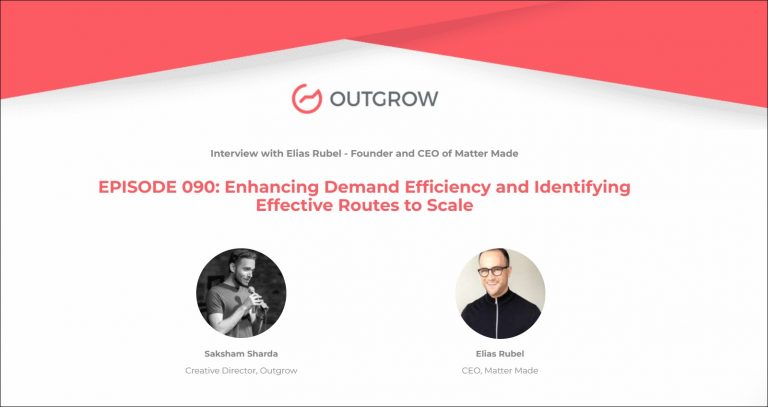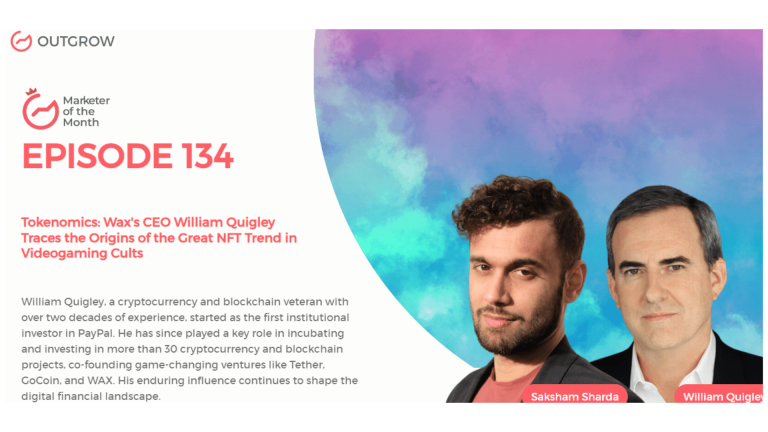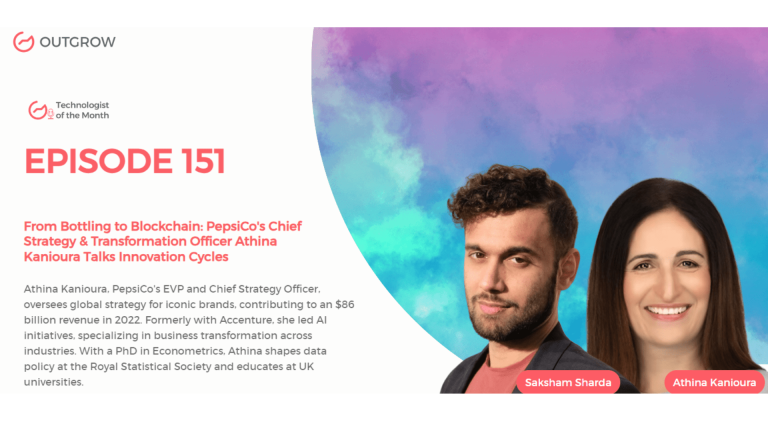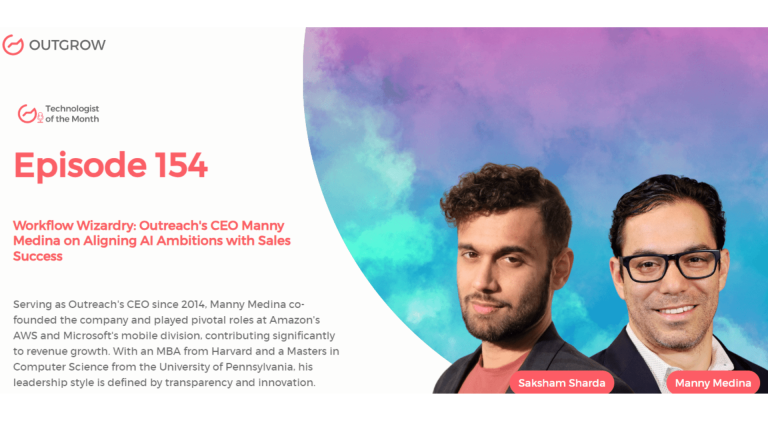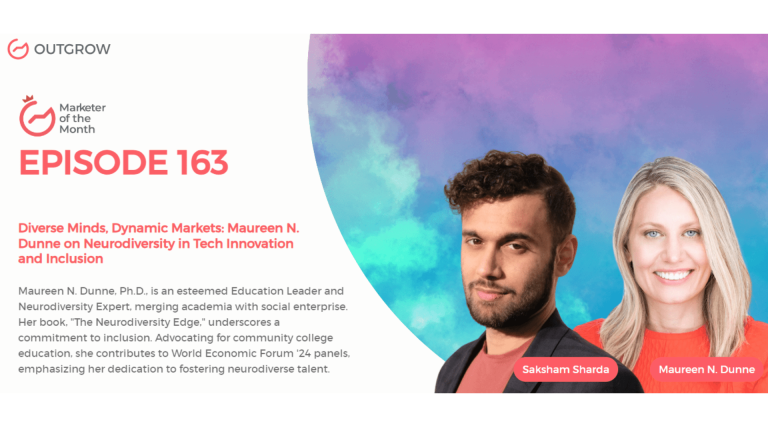EPISODE 136: Marketer of the Month Podcast with Ariel Garten
Table of Contents
Hey there! Welcome to the Marketer Of The Month blog!
We recently interviewed Ariel Garten for our monthly podcast – ‘Marketer of the Month’! We had some amazing insightful conversations with Ariel and here’s what we discussed about-
1. The historical flux of meditation popularity.
2. The recent surge in meditation’s popularity.
3. Technology’s role in meditation’s spread.
4. Meditation’s impact on brain structure.
5. Meditation in education, healthcare, and corporate wellness.
6. Scientific backing for meditation’s benefits.
About our host:
Dr. Saksham Sharda is the Chief Information Officer at Outgrow.co. He specializes in data collection, analysis, filtering, and transfer by means of widgets and applets. Interactive, cultural, and trending widgets designed by him have been featured on TrendHunter, Alibaba, ProductHunt, New York Marketing Association, FactoryBerlin, Digimarcon Silicon Valley, and at The European Affiliate Summit.
About our guest:
Ariel Garten, the founder of Muse and co-founder of InteraXon, introduced brain-controlled computing through Muse. With a background in neuroscience and experience at the Krembil Neuroscience Centre, she’s a former psychotherapist and a successful fashion designer. Her achievements have earned recognition from major media outlets like CNN, Forbes, Popular Science, CNET, CNBC, VentureBeat, TechCrunch, and the Wall Street Journal Tech.
e-Meditation Revolution: Muse’s Founder Ariel Garten on Tech, Zen, Stress, & Leadership Mindfulness
The Intro!
Saksham Sharda: Hi, everyone. Welcome to another episode of Outgrow’s Marketer of the Month. I’m your host, Dr. Saksham Sharda, and I’m the creative director at Outgrow. co. And for this month we are going to interview Ariel Garten who is the founder of Muse.
Ariel Garten: Great to be here. Thank you.
Don’t have time to read? No problem, just watch the Podcast!
Or you can just listen to it on Spotify!
The Rapid Fire Round!
Saksham Sharda: The first question is, at what age do you want to retire?
Ariel Garten: I am already retired.
Saksham Sharda: How long does it take you to get ready in the mornings?
Ariel Garten: Depends on the morning. Typically I roll out pretty ready to rock.
Saksham Sharda: Most embarrassing moment of your life?
Ariel Garten: So I was doing a podcast and I had eaten a sandwich and I had a sandwich stuck inside my teeth and I was picking the sandwich out, but I didn’t realize that although my audio was off, my video was on and they were watching me pick out the sandwich. And then when they noticed I was like, oh my God. And then I had this moment of, oh, why would I be embarrassed about that? We’re all just human. So actually the most embarrassing moment of my life turned out to be an incredibly insightful moment of love, does it matter? We all get sandwich cotton in our teeth. Meditation got me there.
Saksham Sharda: Favorite color?
Ariel Garten: Hot pink.
Saksham Sharda: What time of day are you most inspired?
Ariel Garten: Evening, I’m a night owl.
Saksham Sharda: How many hours of sleep can you survive on?
Ariel Garten: Survive or thrive? Seven and a half to eight is my preference. I don’t like it less than that.
Saksham Sharda: Fill in the blank. An upcoming technology trend is _____.
Ariel Garten: An upcoming technology trend is a great opportunity, I’m not gonna answer that one.
Saksham Sharda: Okay. The city in which the best kiss of your life happened?
Ariel Garten: Toronto is the city in which the best kiss of my life happened where I was born and raised.
Saksham Sharda: Pick one Mark Zuckerberg or Elon Musk.
Ariel Garten: Neither.
Saksham Sharda: The biggest mistake of your career?
Ariel Garten: Pass.
Saksham Sharda: How do you relax?
Ariel Garten: That’s obvious. Meditation.
Saksham Sharda: How many cups of coffee do you drink per day?
Ariel Garten: Zero.
Saksham Sharda: A habit of yours that you hate?
Ariel Garten: Oh, okay. So a habit of mine that I used to have that I hate is being overly defensive. Somebody will bring up something and my ego will go, oh no, I need to hide the fact that I don’t know that. Or, oh no, I need to prove that I’m right. And my husband was the one who pointed out that habit and gave me the impetus to apply the meditation practice that I, you know, so practiced to be able to get outta myself and say, oh yeah, why am I defending that? That’s stupid. So kick that habit out to the curb.
Saksham Sharda: The most valuable skill you’ve learned in life?
Ariel Garten: The most valuable skill I’ve learned in life is how to be kind and loving.
Saksham Sharda: Your favorite Netflix show?
Ariel Garten: Pass.
Saksham Sharda: The last movie that you saw that had an impression on you?
Ariel Garten: Pass.
Saksham Sharda: The last song you’ve been listening to?
Ariel Garten: Pass.
The Big Questions!
Saksham Sharda: Okay, now we go to the longer questions, which you can answer with as much ease and time as you like. How did your background in neuroscience, psychotherapy, design, and fashion influence your journey in co-founding Muse and developing wearable technology for meditation and mindfulness?
Ariel Garten: So, do you want me to just tell my founding story? So I began the journey of founding Muse in the early 2000s. In 2002 I worked in the research lab of Dr. Steve Mann. He’s wearable, he’s the inventor of the wearable computer, the guy who made Google Glass before Google did. And he had an early brain-computer interface device. At the time we were using it to create concerts where people could make music with their brains. 48 people at a time would slip on an electrode to close their eyes, and while they did so the sound in the room would change. And I stood back and said, oh my God, we are interacting with the world with our minds and the world needs to know about this. So I got together with my co-founders, Chris Amny and Trevor Coleman, and the three of us sat around in a basement like every good startup should and was like, what are we gonna do? How are we gonna make this technology sing? And we spent our time doing things like trying to control technology with our minds and make light bulbs glow brighter and sound change. And we realized that as we were teaching people to focus, to make that light bulb glow bright or to relax and then you know, make the music that they’re listening to calm down. What we are teaching them to do is not control the technology that is outside of them, but to control the technology that is inside of them, to be able to manage and control their minds to make that light glow bright or change the music. And that what we are doing is far more valuable than allowing people to interact with tech out there. We are allowing people to understand and interact with their technology, and their mind state, and be able to use it and shift it in ways that are supportive of themselves. So we are set on the path, not of making brain-sensing technology to control the world, but instead making brain-sensing technology to help you reflect on the self. And the first thing that we recognized we could do was to help people meditate. As we were telling people to focus, to make the light go right or relax, we were teaching them to focus and relax. This was in a sense the core of a meditation practice. And when we sat back and said, what do we care about in this world? Like what do we want people to do to make their lives better? An obvious answer was meditation. And if we could only get more people to meditate, the world would be a better place. And so that started the creation of Muse, the brain-sensing headband that helps you meditate and now sleep, which was the beginning of the kickoff of our journey in helping people understand what goes on in their minds using technology.
Saksham Sharda: How does this work? The object in your hand?
Ariel Garten: Yes. So this is the muse. It is a clinical grade, e.g. meaning it is sensors on your forehead and behind your ears. It slips on like a pair of glasses and then it tracks your brain during the meditation practice and sends that data to your smartphone or tablet while you’re meditating. You’re getting real-time feed feedback from your brain to let you know if you’re doing it right. So we all know that meditation is amazing for you, but it can be pretty hard to do. You know, when you sit down to meditate, you sit there, you close your eyes, your brain’s bouncing all over the place and you’re like, this sucks. I’m a terrible meditator. Well, with Muse we aim to change all that. Muse gives you real-time feedback to know when you’re focused, when you’re meditating, and when your mind is wandering. The metaphor we use is your mind is like the weather. So when your mind is wandering, you hear the sound of the rain pick up. And when you close your eyes and relax and focus on your breath, the rain quotes. When you stay focused on your breath in that meditation zone, you get the chirping of birds letting you know that you’re doing it right. So you’re getting real-time feedback during your meditation. And then after the fact you get data charts, graph scores, things that show you what your brain was doing through the course of your meditation and help you improve. So what you measure, you can now improve. You have meditations for the brain, the heart, the breath, and the body. We have an extraordinary set of sleep tools, all of which help you get better insight into yourself and improve the practices that make your life better.
Saksham Sharda: The next question is, can you share some insights into your creative process and how you combine science, neuroscience, emotion, and design to create innovative products?
Ariel Garten: Okay, so I love the creative process. I’m somebody who started in very disparate worlds. My mother was an artist, so I grew up with very beautiful large-scale oil on canvas paintings. I was brought up to believe that from nothing, a blank canvas, you could take what was in your imagination and make it come to life, creating something beautiful and moving. I also grew up in a household where my dad was an entrepreneur and a businessman. And so business was in my blood. I had a lemonade stand when I was five years old and we sold lemonade with raspberries and mint in it because it was a better product. You know, it was like early product marketing. And so my creative process was messy and emotive and engaged, but also very focused on how you could build a business around it. And with that kind of business discipline, I went off to study neuroscience because I was fascinated not just by lemonade, but actually by the brain and how we work. and then brought together the experience of creating stuff along the way. I was a fashion designer because that’s another way of exploring creation in the self and creating cool products and making your ideas come to life, but a terrible business model. and brought all of that entrepreneurial spirit into the work that I did with Dr. Steve Mann in the lab, the inventor of the wearable computer taking clinical grade EEG signals and bringing it into a product. And so it’s been this incredible process of weaving both the emotive parts of life that are meaningful, the technological prowess that you get from a neuroscience degree, and the business sense, all combined with this sort of drive that will never stop. You know, you can have each of these pieces, but as you know, many of you listening are artists and entrepreneurs, and like the thing that drives you is the desire to create and that feeling in there that just won’t let you stop. I just want you to create the thing, bring it out into the world, and make it happen. Along the way, I picked up a meditation practice, which taught me how to stop in a different sense, not how to give up my passion or my ambition, but instead to create a space of quiet and calm that allowed me to mu be much more focused and much more, intentional about what I was doing and choose the right paths rather than being reactive to it and to take feedback on the creations. and like meaningfully utilize that rather than just being defensive. So it’s been this process of creative desire drive, eventual discipline that honed me to be able to take in creative input and drive forward. And then the whole other piece when you’re running a business, which is being able to manage a team and being able to bring people into the vision to be excited about what you’re doing and create an organizational structure that people can work into all work together towards the same goal. So it’s a very complex interweaving, a complex soup that probably a lot of you listening will identify with. and it’s a process that continues. I’m not an expert at any of these pieces yet, but they seem to be getting better and better as I do them as time goes on.
Saksham Sharda: So you talk a lot about wearables. What do you think about Apple’s new VR wearable?
Ariel Garten: So Apple’s new VR wearable is very interesting. Apple getting into something gives you the check mark of it’s real, it’s here and Apple’s gonna do a darn good job of it. whereas the meta versions, you know, still have their awkwardness associated with them and still can be in the corner of a developer or something that’s not necessarily mainstream. Once Apple comes into the play, you know, they have their playbook behind it, you know, they have a range of applications already baked in their mind that are going to be meaningful and hopefully, it won’t go the way of the Google Glass. You know, Google Glass was an awesome experiment where Google threw out this very cool device with no good particular use cases. And so you had a bunch of people walking around with the coolest, latest technology and nothing truly great to do with it, which was fine because that was 10 years ago and technology hadn’t quite caught up to the device and its real capabilities. So, you know, when Apple brings something out, they have a good idea, they have a game plan and they have a use case. So I’m excited to see what’s gonna happen to the world of VR now that Apple’s in the game.
Saksham Sharda: So you started your first research lab at the age of 17, which is quite remarkable. How did that early experience shape your career and passion for neuroscience?
Ariel Garten: So I was lucky enough to work in a research lab at a very young age, so did I wait for that sound to go by? Live from the collision floor, we have lots of acoustic interruptions.
Saksham Sharda: Alright.
Ariel Garten: So from a very young age, I was interested both in art and science. As I said, my mom was an artist and I wondered how the world worked. Like why was this table hard? Why did I think about the world in the way that I did? So I went on to study science and loved it. I’m 43, so this was in, you know, the early 1990s when there wasn’t a big push for girls to be in STEM. I got super lucky and my high school science program had a PCR machine and an early biotechnology focus to it. So I was learning biotech in 1996. and then I was able to start teaching how you like, to extract DNA from basic cells, and how you replicate that DNA in a very simple PCR machine in 1996 in my high school lab. Then from there got a job in a research lab working with Dr. Allen Bernstein, whose lab focus was on hematopoietic stem cells. And they looked at embryonic stem cells in knockout mice. And this was 1997, like as many buzzwords as you could get for the late nineties. And I was, you know, just a very junior assistant in the lab, but I was 17 years old and doing real research with mice and helping and assisting in understanding the development of blood cells, hematopoietic stem cells in these knockout M’S ecosystems. And so that gave me an extraordinary leg up into feeling like I could make an impact in the field of science, gave me both the confidence and the tools and the language to be able to engage with it. And then when I went to university, I went for neuroscience. At the same time, I had a line of clothing that I sold to stores in New York and then when I graduated I opened a little clothing store. So I was always playing between these worlds of art and science. So even at 16, I had a little line of clothing that they carried in the streets of Toronto, like my hometown while I was working on this research. but 17, so there’s always been this tug for me back and forth between science and art, where science is the enabling tools, science is the methodology, and science is the linear process of discovery. Science is a, you know, a form of technology and the emotional part, the human part, the creating experiences part, the, you know, excitement and stimulation part, the color, the life, the sound. And so in the building of news, what we have is very like a technologically capable device, say clinical grade eg, which gets the extraordinary signal, which is used by hundreds, probably thousands of research labs across the world with 200 papers published on it. And we get a beautiful human experience. You get to be able to hear the sound of your mind to be able to, you know, touch with yourself during the practice of meditation in a way that is metaphoric and beautiful. So it’s this, you know, pulling together art and science that allows for the best innovations to exist. And when we think about, you know, the world of gaming, when we think about the technologies that we love, when we think about the devices that Apple makes and how they fit seamlessly and how they’re beautiful, it is that seamless interweaving of extraordinary tech and understanding the human factor and making experiences that delight you.
Saksham Sharda: Do you have any thoughts on neurodiversity and increasing growth? It has come to the focus, it’s come to Baltimore.
Ariel Garten: Hallelujah for neurodiversity. In the very recent past, the idea that somebody would have anxiety, depression, or ADHD was really, truly a stigma. It was the feeling that this person was somehow typical and not normal and therefore not good that it, you know, may taint our environment or you know, the work that that one would be doing if you had somebody like that on your team. And I’ve heard these conversations, they’re unhelpful. Only in the last five years have we recognized that frankly all of us are somewhere on the spectrum of anxious and depressed. Many of us are on the spectrum of other associated labels. Many of us have ADHD characteristics, if not a diagnosis. And all of that is okay. It makes, sometimes, the experience of living quite difficult. I got postpartum OCD and had very intense, intense thoughts in my head that were illogical and nonsensical, but felt so utterly intense and real and I was a mental health professional. It was still hard for me to parse these thoughts. So, living with neuro neurodiversity, living with a divergent mental experience can be extremely valuable in that it gives you insight, new skills, new capabilities, just a different way of being can also be extremely challenging. And so when we approach the question of what is it to be neurodiverse, is this a good thing? Is this a bad thing? I think we first have to say, you know, what it is to be a human, to be a human can be very challenging at times, both mentally and physically. For some people, it can be even more challenging and hard to understand why your mind or your brain seems to work differently than other people. Why do you feel like you’re blue all the time and it sucks? And for other people, they seem to be going about the world as if it’s fine. It can be very hard to reconcile these things. Or you can have voices and thoughts in your head that are just so sticky and compelling and suck, and like, why does everybody else seem to be just acting fine and like not experiencing this? And when you’re able to name it and label it, yes, labels can be bad things, but labels can also be very good things insofar as they can help you understand and put context to your own experience and then allow you to access a myriad of tools and techniques that others who have experienced this can use. Whether it is pharmaceuticals, meditation, talk therapy, CBT, or DBT groups, you know, there are so many tools that you can use to help you make sense of your own internal experience and begin to shift those internal experiences to ones that are more supportive of your own life. So, you know, neurodiversity is amazing. Neurodiversity has made some of the greatest art on this planet. Whether that is, film, writing, songs, visual arts, or neurodiversity ways that don’t serve you can be terrifying, frustrating, and crippling. Again, from some of that comes the ability to communicate about these rather than to create pathos to our human condition, but also it could just make your life suck and feel hard and bad. So, part of my mission in life is to help people understand that the stuff that your brain gives you, the thoughts that your brain is giving you that maybe are not so aligned with the world around you are things that you can understand and shift and change, that you can have agency over your mind insofar as you can have an understanding of it. And so far as you can, you know, stand outside yourself and be the observer of your experience and then take stock of that and say, is this serving me? Do I wanna go down this path or is it not serving me and maybe is it serving me sometimes? And I wanna choose to be here when I wanna be here and also have the tools to take myself out of here when it doesn’t serve me to be there. So, psychotherapy is a great tool for training as a psychotherapist. Meditation is an essential tool to help create that sense of observer and be able to get yourself out of your mind to be able to recognize what’s going on. Because otherwise you may just be subsumed by it. And to become a practice that allows you to identify when you’re thinking maybe is divergent in ways that aren’t serving at that moment, or to notice that your thoughts are being divergent and to use it if it’s, you know, a creation for great art at that moment or something helpful or stop doing it if it’s something that’s hurting the people around you. You know these are the sort of self-observations that something like meditation can help you make. And then tools and techniques like CBT or DBT and a range of other psychotherapeutic methodologies as well as pharmacology, can help you gain real perspective. If you lived your life with anxiety and you then get on Paxil or Prozac or Zoloft for a period of time and realize, oh my god, I don’t need to feel that way, that can be an incredible tool to help you understand the range of you that the range of you can go from super anxious to okay feeling like normal and grounded and able to engage and then becomes a then becomes like a methodology to help you learn, oh, well when I’m here I do have the option to bring myself here, whether it’s with pharmacological help or without, now that I know I can get here, you know, what are the other means that I can use now that I’ve tasted it, now that I understand it, now that I can build capacity and return to this state. So this is a very long-winded answer to the question of what I think about neurodiversity, but here are many of my stream-of-consciousness thoughts on the subject. Sorry about that.
Saksham Sharda: So in contrast to using drugs or smart drugs to optimize brain chemistry, how does meditation go beyond altering brain chemistry and changing the structure of the brain permanently?
Ariel Garten: Okay, so meditation makes real changes in the brain. So meditation is not just this thing that you do that feels good, it actually can change the meat of this organ in your head in a number of different ways. So number one, the part of your head you have is your frontal cortex. The frontal cortex is kind of essential because it’s part of our brain that’s associated with our higher-order processing, our planning, our attention, and our inhibition. It’s the thing that separates us from other mammals. Now, bad news, as you age your prefrontal cortex thinks good news. If you’re able to maintain a long-term meditation practice, you can maintain the thickness of your prefrontal cortex even as you age. This work comes from the lab of Dr. Sarah Lazar. She had several individuals who were long-term meditators, defined as meditating for five years or more. One of them was 50 years old and had the prefrontal cortex thickness of a 25-year-old. The next thing that happens, so there’s this little part of your brain right here called the amygdala. The amygdala is part of your brain that is scanning for danger. It’s the emotional center of your brain that’s responsible for your fight-or-flight response. It’s the thing that freaks out when things go bad. Bad news, your amygdala is kind of like a two-year-old having a temper tantrum. The good news, your prefrontal cortex’s role is to manage your amygdala. So what we see in even short-term meditators is a decrease in the activation of the amygdala. So that part of you that’s freaking out when things are scary is not freaking out so much more. In long-term meditators, it’s even been demonstrated that you see increased projections from the prefrontal cortex to the amygdala. So it’s kind of like the prefrontal, it’s kind of like if the amygdala is a little two-year-old who sees a shadow on the wall and goes like I’m freaking out. It’s a shadow on the wall. The prefrontal cortex is the parent that comes in and says, let’s look around, scan the scene just a shadow. Let’s turn on the lights down, little amygdala, calm down. It’s okay. And actually in long-term meditators, as I said, you’re seeing an increase in the ability of the prefrontal cortex to down-regulate the amygdala. Increased projections and increased ability to manage. It’s a freaked-out little self. So real change in the brain, several amazing other things happen. One is meditation has been demonstrated to maintain the volume of your hippocampus. The hippocampus is the seat of your learning and memory as you age. Your hippocampus shrinks also because cortisol has a habit of damaging and shrinking the hippocampus. Meditation allows you to decrease your cortisol levels because you’re much calmer and can maintain the volume of your hippocampus as you age for better learning and memory meditation can also increase the density of your gray matter. So the amount of gray matter you have is the number of neural connections in your brain. So for reference, Einstein had more gray matter than the average individual. Dr. Sarah Lazar’s lab has shown that even just eight weeks of meditation has been able to increase the density of that gray matter. More gray matter, probably more smarts. Meditation has also been shown to increase the connections in your corpus colossal, the communication between your left and right hemispheres. It’s also been demonstrated to up-regulate activity in the TPJ, the temporal parietal junction, which is responsible for empathy, compassion, and perspective-taking. So in short, these were just a few of the many more ways that meditation impacts the physical structure of your brain. The best ones save for the last meditation can even decrease the aging of your brain. So an amazing study showed that long-term meditators had brains that looked on average 7.5 years younger than short-term meditators. This is the work of Dr. Eileen Looters and she looked at long-term meditators, which she defined as people who’d been meditating for five years or more. So meditation of five years or more can lead to 7.5 years of a younger-looking brain. Pretty good investment of 10 minutes a day, I think.
Saksham Sharda: Why do you think meditation has constantly, I don’t know whether it has come back, it’s been important in the history of mankind for a long time, but it comes into cultures that it goes away for a while or does it come or do you think it’s been consistently there in all cultures when some cultures it’s more, it’s less?
Ariel Garten: So we’ve seen this even flow of meditation over time. Meditation is kind of like the OG technology. You know, 2,000 years ago when forms of meditation were being created and passed down and taught, it was a technology to help you query the mind and observe the mind and change your body and physiology. Before there were, you know, apple watches to track your heart rate, meditation was a tool that you would use to observe yourself and to be able to see what your heart was doing. Before we had IQ tests, you know, before we had things that allowed us to query our minds, meditation was a tool that allowed you to sit there and observe your mental process and allow you to rewire your brain and your own body. It is an extraordinary early technology. We have seen the rise and fall of that technology several times. So in Western culture, for example, we didn’t get great exposure to meditation until the seventies brought the fascination with Orientalism. It’s probably really not a PC term these days. And the hippie movement brought that fascination into North America. Meditation became in vogue. It then sort of petered under the, you know, under the covers. You didn’t see a lot of public meditation until the early 2010s. By 2013, meditation was on the cover of Time Magazine, and that kind of marked this extraordinary shift into meditation being part of popular culture. Now, side note, I should mention that in India, in Asia, in Buddhist cultures meditation has been going strong the entire time. You know, meditation is also the religious practice of engaging with the self or engaging with a God depending on the lineage that you come out of. There’s Christian meditation, there’s even Jewish capitalistic meditation, there are Buddhist meditations and a very extraordinary lineage of teachings that come from there. So, you know, by telling this North American story, I in no way mean to suggest that meditation isn’t, wasn’t alive and kicking the entire time elsewhere. I’m just sort of telling the American pop culture story. So in American pop culture in the early two thousand, you started to see celebrities meditating by 2010. You know, you’re getting articles about CEOs meditating and athletes meditating. 2013, it’s on the cover of Time magazine. Oprah’s starting to do it. And now you’re getting the mass filtration down. You’re getting people starting to say I should meditate. but not knowing how to do it. Headspace came out about that time and is starting to gain in popularity. So you’re getting the apps coming in because you had the iPhone, you had a mechanism starting in 2010 that allowed you to have apps on your phone so that you could do these things and have a wider dissemination of it. By 2014, we came to market with Muse, a brain-sensing headband that could help you meditate. And when we were pitching for Muse back in 2010-11-12, we’d go to VCs and they’d be like, your technology is amazing. What’s the killer app? And we’d say to help you meditate. And they would laugh us out of the office by 2023, those very same VCs meditate with Muse. True story. So, you know, the curve has gone like this to where you started to have tech investment in it. You had calm.com, The guy from Calm paid a million dollars for his webpage that was gonna just say calm on it. That was the very first thing it did. And it was a beautiful scene that just made you feel calm. So you start to see the tech investment falling in, which then enables more technological deployment. You know, our popularity went from a device that was used by a few thousand people in 2012 when we first came out to, you know, more in 2014 to now 2023, half a million people around the world have used Muse to start or enhance their meditation practice. You now have this medical sphere on it. You now have the idea of preventative medicine and healthcare and well care rather than sick care. So everybody knows that meditation is good for you because it can help you regulate your eating, regulate your physiology, decrease your chance of a heart attack, as well as all the lovely softer stuff. Like having better relationships, having an increased sense of self, you know, evolving to be a better person. We’ve come to the moment of the zeitgeist where so many people meditate that it is, it becomes a badge of honor. So in the same way that seven or eight years ago carrying a yoga mat down the street and wearing Lululemons was like the badge of, oh, you are cool, you’re somebody who’s doing good for yourself. You now have to meditate. If you’re somebody who is, you know, wanting to look like they are an evolved person, the good news is meditation does help you become an evolved person and possibly care less about what other people think of you in your meditation practice. But it’s, yeah, it’s reached an inflection point where, you know, people in middle America are learning meditation in school where it is a thing that your doctor is telling you to do. It is a thing that, you know, people buy things for their sisters-in-law because they think that she should meditate and like to get into it. So meditation, we now understand its benefits. There are over 10,000 publications that demonstrate the value of meditation to improve your attention, decrease your stress, decrease your heart rate, change your risk of hypertension, improve your GRE scores, you know, help you do better at work. And, so meditation is here, I think this time to stay. it’s moved, it’s in the trend curve, but it’s moved beyond the trend curve because it has a real impactful value in people’s lives. And once you start a practice and get it to stick, most people say, I wanna meditate every day because it makes my life feel better. You don’t hear that about, you know, the latest trend or the latest, you know, nail polish or whatever. It’s, so I’m proud to be on the curve of making real lasting change in people’s lives.
Saksham Sharda: What would you be doing in your life, if not this right now?
Ariel Garten: So my life’s mission is to help people understand that the crap that goes on in your head doesn’t need to hold you back. Those thoughts and feelings that you have of I’m not good enough. Oh no, you know, I’m not a real capable human being. My life’s mission is to help you understand that those thoughts and feelings are just things that your brain is serving you and not things that you need to believe or buy into. and to know that some tools, techniques, and technologies can help you observe those thoughts, move them aside, and make better choices for what fills your mind in your own life. So if I wasn’t building Muse as a brain-sensing headband to help you meditate, I would be teaching it in a different form. You know, it’s not about technology, it’s about you living a better life. Muse is one way to get there and it’s effective. and there are lots of ways to get there. All I care about is that more people understand that they are awesome and don’t let those voices in their heads hold them back.
Let’s Conclude!
Saksham Sharda: Thanks, everyone for joining us for this month’s episode of Outgrow’s Marketer of the Month. That was Ariel Garten who is the founder of Muse.
Ariel Garten: Pleasure. Thanks for having me.
Saksham Sharda: Check out the website for more details and we’ll see you once again next month with another marketer of the month.
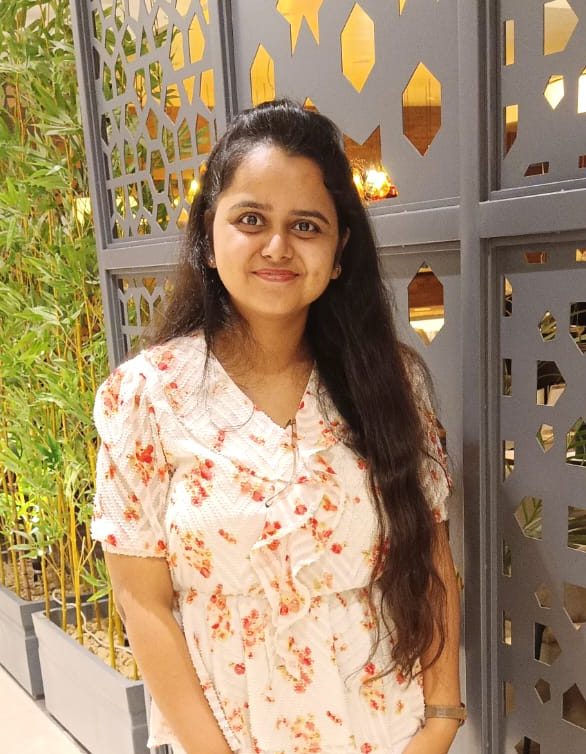
Muskan is a Marketing Analyst at Outgrow. She is working on multiple areas of marketing. On her days off though, she loves exploring new cafes, drinking coffee, and catching up with friends.




